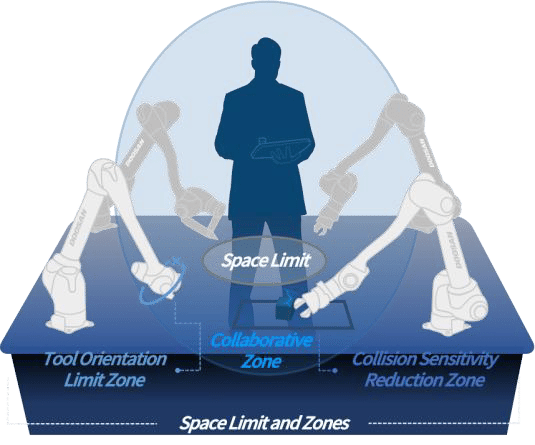Optimize Cobot Performance Without Sacrificing Safety
Optimize performance without sacrificing safety with Doosan Cobots
Doosan Robotics is leading the cobot market in innovative safety features that allow you to maintain productivity while keeping your team as safe as possible. Doosan offers cobots with the industry’s highest safety rating, PL e Cat 4. Their emphasis on innovation means that they go beyond what the market has come to expect in cobot safety by creating unique options and features.
Safety Zones
Doosan takes safety zones to a whole new level by offering up to 20 safety zones in various shapes (spherical, cylindrical, rectangular parallelepiped, etc.). In addition, the cobot will monitor the movement of the entire arm, not just the elbow and tool center point (TCP). It is possible to set custom limit values or safety-rated stops in each of the zones. This ensures that the entire arm behaves as you would like within each zone.
Safety Zone Settings
Users have the ability to set space restrictions and five different zone settings within the three-dimensional zones discussed above. These options include space restriction, cooperative work zone, stricture prevention zone, collision sensitivity reduction zone, tool directional change restriction zone, and user-defined zone. These zones allow the control of a number of variables including joint angle, joint speed, TCP speed, TCP force, power, momentum, robot/TCP position, tool outfit position, whole body collision sensitivity, and tool direction. Having these options allows you to optimize the robot program for each application in a way that maximizes productivity while also protecting worker safety.
Set for collaborative work between robot and operator
- During collision – complies with external force before stop is engaged
- Reduces risk of limbs being trapped between robot and obstacles
- Fixes TCP speed at 200mm/s or less
- Sets collision sensitivity to max
- Otherwise treated as collaborative zone
High-priority zone – allows user to set higher or lower limits for collision detection and TCP force when contact with workpiece/equipment is required (e.g. assembly tasks)
Reduces risks related to the direction of the tool/workpiece when TCP enters the zone
User-defined safety limits as needed
Collision Detection
Doosan is able to achieve significantly lower impact forces during collisions than its competitors for the entire working speed because they have increased collision detection sensitivity – as low as 5N depending on the model.
Curved Design
Even the physical design of Doosan cobots is intended to keep safety first. The distinctive curved arm was specifically designed to prevent pinch points, keeping operators safe.
LED Light
All Doosan cobots are equipped with an LED light on the flange (H/M series) or base (A series) that can quickly provide critical information. This helps you to know right away if the robot is in collaborative mode, standby, emergency stop, etc. You can learn more by reading our article on Doosan’s LED light color coding.
If you are looking for repeatability and speed without sacrificing safety, Doosan might be the right fit for you. Contact the Cross Automation team today to discuss your specific application.

